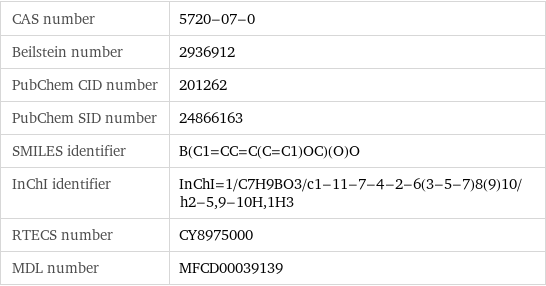Input interpretation

p-anisylboronic acid
Chemical names and formulas

formula | CH_3OC_6H_4B(OH)_2 Hill formula | C_7H_9BO_3 name | p-anisylboronic acid IUPAC name | (4-methoxyphenyl)boronic acid alternate names | 4-methoxybenzeneboronic acid | (4-methoxyphenyl)boronic acid | boronic acid, (4-methoxyphenyl)- | p-methoxybenzeneboronic acid | p-methoxyphenylboronic acid mass fractions | B (boron) 7.11% | C (carbon) 55.3% | H (hydrogen) 5.97% | O (oxygen) 31.6%
Lewis structure

Draw the Lewis structure of p-anisylboronic acid. Start by drawing the overall structure of the molecule, ignoring potential double and triple bonds: Count the total valence electrons of the boron (n_B, val = 3), carbon (n_C, val = 4), hydrogen (n_H, val = 1), and oxygen (n_O, val = 6) atoms: n_B, val + 7 n_C, val + 9 n_H, val + 3 n_O, val = 58 Calculate the number of electrons needed to completely fill the valence shells for boron (n_B, full = 6), carbon (n_C, full = 8), hydrogen (n_H, full = 2), and oxygen (n_O, full = 8): n_B, full + 7 n_C, full + 9 n_H, full + 3 n_O, full = 104 Subtracting these two numbers shows that 104 - 58 = 46 bonding electrons are needed. Each bond has two electrons, so in addition to the 20 bonds already present in the diagram add 3 bonds. To minimize formal charge carbon wants 4 bonds. Identify the atoms that want additional bonds and the number of electrons remaining on each atom: Fill in the 3 bonds by pairing electrons between adjacent highlighted atoms. Note that the six atom ring is aromatic, so that the single and double bonds may be rearranged: Answer: | |
Basic properties

molar mass | 151.96 g/mol phase | solid (at STP) melting point | 205 °C
Units

Chemical identifiers

CAS number | 5720-07-0 Beilstein number | 2936912 PubChem CID number | 201262 PubChem SID number | 24866163 SMILES identifier | B(C1=CC=C(C=C1)OC)(O)O InChI identifier | InChI=1/C7H9BO3/c1-11-7-4-2-6(3-5-7)8(9)10/h2-5, 9-10H, 1H3 RTECS number | CY8975000 MDL number | MFCD00039139
NFPA label

NFPA label

NFPA health rating | 2 NFPA fire rating | 0 NFPA reactivity rating | 0
Toxicity properties

RTECS classes | other